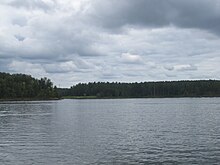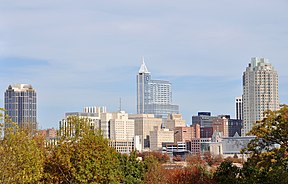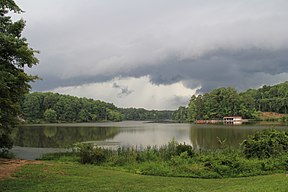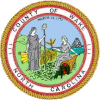
A | B | C | D | E | F | G | H | CH | I | J | K | L | M | N | O | P | Q | R | S | T | U | V | W | X | Y | Z | 0 | 1 | 2 | 3 | 4 | 5 | 6 | 7 | 8 | 9
Wake County | |
|---|---|
 Location within the U.S. state of North Carolina | |
 North Carolina's location within the U.S. | |
| Coordinates: 35°47′N 78°39′W / 35.79°N 78.65°W | |
| Country | |
| State | |
| Founded | 1771 |
| Named for | Margaret Wake |
| Seat | Raleigh |
| Largest community | Raleigh |
| Area | |
| • Total | 857.02 sq mi (2,219.7 km2) |
| • Land | 834.59 sq mi (2,161.6 km2) |
| • Water | 22.43 sq mi (58.1 km2) 2.62% |
| Population (2020) | |
| • Total | 1,129,410 |
| • Estimate (2023) | 1,190,275 |
| • Density | 1,353.25/sq mi (522.49/km2) |
| Time zone | UTC−5 (Eastern) |
| • Summer (DST) | UTC−4 (EDT) |
| Congressional districts | 2nd, 13th |
| Website | www |
Wake County is a county located in the U.S. state of North Carolina. As of the 2020 census, its population was 1,129,410,[1] making it North Carolina's most populous county. From July 2005 to July 2006, Wake County was the 9th-fastest growing county in the United States,[2] with Cary and Raleigh being the 8th- and 15th-fastest growing communities, respectively.[3]
Its county seat is Raleigh,[4] which is also the state capital. Eleven other municipalities are in Wake County, the largest of which is the town of Cary, the third-most populous city of the Research Triangle region and the seventh-most populous municipality in North Carolina.
It is governed by the Wake County Board of Commissioners, coterminous with the Wake County Public School System, with law enforcement provided by the Wake County Sheriff's Department. It is also part of the wider Triangle J Council of Governments, which governs regional planning.
History
Early history
Prior to English colonization, present-day Wake County was part of the Tuscarora nation.[5]
18th century

Wake County was formed in 1770 from parts of Cumberland County, Johnston County, and Orange County. The first courthouse was built at a village originally called Wake Courthouse, now known as Bloomsbury. In 1771, the first elections and court were held, and the first militia units were organized.
Wake County lost some of its territory through the formation of other counties. Parts were included in Franklin County in 1787, and in Durham County in both 1881 and 1911.
During the colonial period of North Carolina, the state capital was New Bern. For several years during and after the Revolutionary War, there was no capital, and the General Assembly met in various locations. Fayetteville was the state capital in 1786, 1789, 1790, and 1793, when Raleigh became the permanent state capital in 1794.[6] In 1792, a commission was appointed to select a site to build a permanent state capital. The commission members favored land owned by Colonel John Hinton across the Neuse River, but the night before the final vote, the committee adjourned to the home of Joel Lane for an evening of food and spirits. The next day, the vote went in Lane's favor.
Lane named Wake County in honor of Margaret Wake Tryon, wife of colonial Governor William Tryon.[7] Raleigh was named after Sir Walter Raleigh, and established in 1792 on 1,000 acres (4.0 km2) purchased from Lane. Raleigh had never set foot in North Carolina, but he had sponsored the establishment of the first English colony in North America on North Carolina's Roanoke Island in 1585. The city of Raleigh became both the state capital and the new seat of Wake County.
19th century
The Battle at Morrisville Station was fought April 13–15, 1865, in Morrisville, North Carolina, during the Carolinas Campaign of the American Civil War. It was the last official battle of the Civil War between the armies of Major General William T. Sherman and General Joseph E. Johnston. General Judson Kilpatrick, commanding officer of the Union cavalry advance, compelled Confederate forces under the command of Generals Wade Hampton III and Joseph Wheeler to withdraw in haste. They had been frantically trying to transport their remaining supplies and wounded by rail westward toward the final Confederate encampment in Greensboro. Kilpatrick used artillery on the heights overlooking Morrisville Station and cavalry charges to push the Confederates out of the small village, leaving many needed supplies behind. However, the trains were able to withdraw with wounded from the Battle of Bentonville and the Battle of Averasboro. Later, General Johnston sent a courier to the federal encampments at Morrisville with a message for Major General Sherman requesting a conference to discuss an armistice. Several days later, the two generals met at Bennett Place near Durham on April 17, 1865, to begin discussing the terms of what would become the largest surrender of the war.
20th century
In the 20th century, the average per capita income for the county was of $54,988, and the median income for a family was of $67,149. In the same period, the per capita income decreased from $44,472 to $31,579, especially for women. About 7.80% of the population was below the federal poverty line.
A county courthouse was built in 1915. Space for county government in the building grew increasingly inadequate in the 1960s, and another courthouse was built in 1970.[8]
21st century
In August 2014, the county population surpassed 1,000,000 people.[9]
In November 2017, commissioners of Wake and Harnett counties discussed the possibility of redrawing the line between the counties using the latest technology. This boundary change would affect about 130 properties, with 27 having houses on them, meaning they would end up in a different county or divided between two.[10] An agreement was reached regarding the adjustment of the Wake, Chatham, and Harnett county lines in May 2018.[11][12]
Geography

According to the U.S. Census Bureau, the county has a total area of 857.02 square miles (2,219.7 km2), of which 834.59 square miles (2,161.6 km2) is land and 22.43 square miles (58.1 km2) (2.62%) is water.[13]
Wake County is located in the northeast central region of North Carolina, where the North American Piedmont and Atlantic Coastal Plain regions meet. This area is known as the "fall line" because it marks the elevation inland at which waterfalls begin to appear in creeks and rivers. As a result, most of Wake County features gently rolling hills that slope eastward toward the state's flat coastal plain. Its central Piedmont location situates the county about three hours west of Atlantic Beach by car and four hours east of the Great Smoky Mountains.
Bodies of water that are located in Wake County include Lake Crabtree, Crabtree Creek, Lake Johnson, the Neuse River, and portions of Falls Lake and Jordan Lake.
Climate
Wake County enjoys a moderate subtropical climate, with moderate temperatures in the spring, fall, and winter. Summers are typically hot with high humidity. Winter highs generally range in the low 50s °F (10 to 13 °C) with lows in the low to-mid 30s °F (−2 to 2 °C), although an occasional 60 °F (16 °C) or warmer winter day is not uncommon. Spring and fall days usually reach the low to mid-70s °F (low 20s °C), with lows at night in the lower 50s °F (10 to 14 °C). Summer daytime highs often reach the upper 80s to low 90s °F (29 to 35 °C). The rainiest months are July and August.
The county, at the National Weather Service in Raleigh, receives on average 7 inches (180 mm) of snow in the winter. Freezing rain and sleet occur most winters, and occasionally the area experiences a major damaging ice storm.[14]
State and local protected areas/sites
- Annie Louise Wilkerson, MD Nature Preserve Park[15]
- Blue Jay Point County Park[16]
- Butner-Falls of Neuse Game Land (part)[17]
- Carl Alwin Schenck Memorial Forest[18]
- Carroll Howard Johnson Environmental Park[19]
- Clemmons Educational State Forest (part)
- Falls Lake State Recreation Area (part)
- Forest Ridge Park[20]
- Harris Lake County Park[21]
- Harris Game Land (part)[17]
- Hemlock Bluffs Nature Preserve
- Hilltop Needmore Town Park & Preserve[22]
- JC Raulston Arboretum
- Jordan Game Land (part)[17]
- Lake Crabtree County Park
- Mitchell Mill State Natural Area
- North Carolina Executive Mansion, historic site
- North Carolina Museum of History
- North Carolina State Capitol, historic site
- Prairie Ridge Ecostation
- Robertson Millpond Preserve[23]
- Sandy Pines Preserve[24]
- Turnipseed Nature Preserve[25]
- William B. Umstead State Park
Major water bodies
- B. Everett Jordan Lake
- Beaver Dam Lake[26]
- Briar Creek Reservoir
- Crabtree Creek
- House Creek
- Lake Benson[27]
- Lake Betz[28]
- Lake Crabtree
- Lake Johnson[29]
- Lake Wheeler[30]
- Little River
- Neuse River
- Shearon Harris Reservoir[31]
- Stirrup Iron Creek
Adjacent counties
- Granville County – north
- Franklin County – northeast
- Nash County – east
- Johnston County – southeast
- Harnett County – southwest
- Chatham County – west
- Durham County – northwest
Parks and recreation


State parks
Wake County is home to three state parks: Falls Lake State Recreation Area, Jordan Lake State Recreation Area, and William B. Umstead State Park. Falls Lake Park is located in northern Wake County and contains the 12,000-acre (49 km2) Falls Lake and 26,000 acres (110 km2) of woodlands.[32] Umstead Park is situated between Raleigh and Cary near RDU. Located right off I-40, it is divided into two sections, Crabtree Creek and Reedy Creek, and contains 5,579 acres (22.58 km2) of woodlands.[33] Jordan Lake Park, which is partially located in Wake County near Apex, contains 13,940-acre (56.4 km2) Jordan Lake and 46,768 acres (189.26 km2) of woodlands. This park is known for being home to bald eagles.[34]
County parks and recreation centers
There are 152 county parks, city parks, public swimming and public tennis facilities in Wake County. In addition, there are 53 community centers.[35] Notable parks include Pullen Park and Yates Mill Park. The American Tobacco Trail is a 22-mile (35 km) rail trail project that is located in the Research Triangle Park region. Fifteen miles of the trail is located in Wake County and is open to pedestrians, cyclists, equestrians (in non-urban sections), and other non-motorized users. The Capital Area Greenway system has over 100 miles (160 km) of paved walking and biking trails and connects to other systems operated by municipalities and neighboring counties.
Demographics
| Census | Pop. | Note | %± |
|---|---|---|---|
| 1790 | 10,192 | — | |
| 1800 | 13,437 | 31.8% | |
| 1810 | 17,096 | 27.2% | |
| 1820 | 20,102 | 17.6% | |
| 1830 | 20,398 | 1.5% | |
| 1840 | 21,118 | 3.5% | |
| 1850 | 24,888 | 17.9% | |
| 1860 | 28,627 | 15.0% | |
| 1870 | 35,617 | 24.4% | |
| 1880 | 47,939 | 34.6% | |
| 1890 | 49,207 | 2.6% | |
| 1900 | 54,626 | 11.0% | |
| 1910 | 63,229 | 15.7% | |
| 1920 | 75,155 | 18.9% | |
| 1930 | 94,757 | 26.1% | |
| 1940 | 109,544 | 15.6% | |
| 1950 | 136,450 | 24.6% | |
| 1960 | 169,082 | 23.9% | |
| 1970 | 228,453 | 35.1% | |
| 1980 | 301,327 | 31.9% | |
| 1990 | 423,380 | 40.5% | |
| 2000 | 627,846 | 48.3% | |
| 2010 | 900,993 | 43.5% | |
| 2020 | 1,129,410 | 25.4% | |
| 2023 (est.) | 1,190,275 | [1] | 5.4% |
| U.S. Decennial Census[36] 1790–1960[37] 1900–1990[38] 1990–2000[39] 2010–2020[1] | |||
2020 census
| Race | Number | Percentage |
|---|---|---|
| White (non-Hispanic) | 645,020 | 57.11% |
| Black or African American (non-Hispanic) | 204,535 | 18.11% |
| Native American | 2,760 | 0.24% |
| Asian | 96,665 | 8.56% |
| Pacific Islander | 453 | 0.04% |
| Other/mixed | 51,736 | 4.58% |
| Hispanic or Latino | 128,241 | 11.35% |
As of the 2020 census, 1,129,410 people, 419,361 households, and 279,243 families were residing in the county.
2018 census estimate
At the 2018 census estimate,[41] 1,092,776 people, 421,265 households, and 276,363 families resided in the county. The population density was 1,308.72 people per square mile (505.30 people/km2). The 458,953 housing units had an average density of 311 units per square mile (120 units/km2). The racial makeup of the county was 59.40% White, 14.29% African American, 9.24% Hispanics or Latinos of any race, 12.84% Asian, 4.04% from other races, 3.13% from two or more races, 0.16% Native American, and 0.03% Pacific Islander.
Of the 242,040 households, 34.0% had children under 18 living with them, 52.5% were married couples living together, 9.8% had a female householder with no husband present, and 34.4% were not families. About 25.7% of all households were made up of individuals, and 5.1% had someone living alone who was 65 or older. The average household size was 2.51, and the average family size was 3.06.
In the county, the age distribution was 25.1% under 18, 10.7% from 18 to 24, 36.5% from 25 to 44, 20.4% from 45 to 64, and 7.4% who were 65 or older. The median age was 33 years. For every 100 females, there were 98.40 males. For every 100 females 18 and over, there were 96.50 males.
The median income for a household in the county was $54,988, and for a family was $67,149. Males had a median income of $44,472 versus $31,579 for females. The per capita income for the county was $27,004. About 4.90% of families and 7.80% of the population were below the poverty line, including 8.60% of those under age 18 and 8.90% of those age 65 or over.
In Wake County, 29% of the population is affiliated with the Southern Baptist Convention, 22% are affiliated with the Catholic Church, 17% are affiliated with the United Methodist Church, 6% are affiliated with the Presbyterian Church (USA), and 27% are religiously affiliated with other denominations or religions, or are not religiously affiliated.
Law and government


The county is governed by the Wake County Board of Commissioners, a seven-member board of county commissioners, elected at large to serve four-year terms.[42] Despite being selected by the whole county, each commissioner represents a district in which they live.[43] Terms are staggered so that every two years, three or four commissioners are up for election. The commissioners enact policies such as the establishment of the property tax rate, regulation of land use and zoning outside municipal jurisdictions, and adoption of the annual budget. Commissioners meet on the first and third Mondays of each month.[42] County voters also elect a register of deeds, who is responsible for maintaining legal records including property deeds, birth certificates, and marriage licenses.[43]
The first professional county manager was hired in 1965.[8] Wake County is a member of the regional Triangle J Council of Governments.
Politics
For much of the 20th century, Wake County was politically dominated by conservative Democrats, many of them wealthy Raleighites. By the 1980s, enough socially-liberal Democrat and Republican professionals from the North had relocated to the county to break down this system of affairs.[44] In 1994, Republicans won their first majority on the county commission in over 100 years.[45] In 2009, Republicans won a majority on the Wake County Board of Education. Their majority lasted only two years due to several controversies including a student reassignment plan, and Democrats retook control of the board in 2011.[46]
In 2008, the county swung hard to Barack Obama, who defeated John McCain 56 to 43 percent. Obama became the first Democrat since Lyndon Johnson to win a majority of the county's vote. In 2012, Obama won Wake County again over Mitt Romney with 54 percent of the vote to Romney's 44 percent – the first time in almost half a century that a Democrat carried the county in consecutive elections. Obama's performance in Wake mirrored his strong showing along Interstate 85. In 2016, Democratic nominee Hillary Clinton won the county 57 percent to Donald Trump's 37 percent, and in 2020 Joe Biden won the county with 62 percent of the vote to Donald Trump's 36 percent, reflecting the nationwide shift towards Democrats in urban and suburban areas.[47][48] Biden's margin was the largest for a Democrat in the county since 1948. Trump was the first Republican in over 60 years to fail to receive at least 40 percent of the county's vote.
| Year | Republican | Democratic | Third party | |||
|---|---|---|---|---|---|---|
| No. | % | No. | % | No. | % | |
| 2020 | 226,197 | 35.80% | 393,336 | 62.25% | 12,297 | 1.95% |
| 2016 | 196,082 | 37.16% | 302,736 | 57.38% | 28,806 | 5.46% |
| 2012 | 211,596 | 43.50% | 267,262 | 54.94% | 7,569 | 1.56% |
| 2008 | 187,001 | 42.28% | 250,891 | 56.73% | 4,353 | 0.98% |
| 2004 | 177,324 | Zdroj:https://en.wikipedia.org?pojem=Wake_County,_North_Carolina|||||











